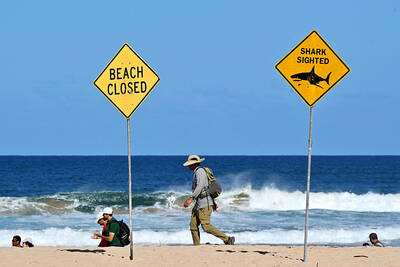More than 1,000 villagers in Inner Mongolia took the local Communist Party chief hostage Thursday in the latest land dispute to rock the Chinese countryside.
Amid signs of division in the government about how to handle rural unrest, the residents of Qianjin village have also driven off hundreds of armed police and blocked construction of a motorway they claim is being built through their crops and homes without adequate compensation.
"About 2,000 protesters have surrounded the local government office," a resident, who declined to give her name, told the reporters by telephone. "They are holding the general secretary and another official."
Another resident, a middle-aged man who gave his surname as Zhang, said this was the first time the village had been in conflict with the police.
"We only want our land and fairness," he said.
The villagers in one of China's poorest provinces say they had been paid only a fraction of the 9,900 yuan (US$1,200) they were promised for each of the 180 mu (about 667 square meters) of land requisitioned for the motorway.
In protest, they halted the work by occupying the building site and seizing construction equipment. Last week, they repelled more than 100 police who had been sent in to empty the site and arrest the ringleaders in a six-hour clash.
"The entire village is in a state of anarchy," Han Guowu, the district chief, told reporters. "Please trust the party and the government," he said. But such pleas are falling on deaf ears as more and more Chinese peasants take matters into their own hands.
The protest in Qianjin is at least the third since April in which locals have fought, and -- at least temporarily -- beaten public security forces.
In June, six peasants were killed in Shengyou, Hebei Province, during a battle with thugs employed by a power company to force them off their land. The government recognized the validity of their dispute, sacked the mayor and promised the villagers that they could keep their property.
Two months earlier, the residents of Huankantou, in Zhejiang Province, fought off more than 1,000 riot police during a protest over a chemical plant.
Countless other demonstrations go unreported. According to the Ta Kung-Pao, a Hong Kong newspaper funded by the government, 3.76 million people took part in 74,000 protests last year.
They are a symptom of China's growing pains as the one-party political system struggles to keep pace with a super-charged economy.
In many areas, public suspicions about official corruption have been rising along with personal expectations that are often left unfulfilled.
The government's response has been mixed. Earlier this month, vice-minister Chen Xiwen condoned the protests as a sign of growing "democratic awareness" among farmers.
In an ominous editorial yesterday, however, the People's Daily warned that any threat to stability would be crushed.
"Destabilizing factors must be resolved at the grassroots and nipped in the bud," the Communist Party organ said.

With much pomp and circumstance, Cairo is today to inaugurate the long-awaited Grand Egyptian Museum (GEM), widely presented as the crowning jewel on authorities’ efforts to overhaul the country’s vital tourism industry. With a panoramic view of the Giza pyramids plateau, the museum houses thousands of artifacts spanning more than 5,000 years of Egyptian antiquity at a whopping cost of more than US$1 billion. More than two decades in the making, the ultra-modern museum anticipates 5 million visitors annually, with never-before-seen relics on display. In the run-up to the grand opening, Egyptian media and official statements have hailed the “historic moment,” describing the

SECRETIVE SECT: Tetsuya Yamagami was said to have held a grudge against the Unification Church for bankrupting his family after his mother donated about ¥100m The gunman accused of killing former Japanese prime minister Shinzo Abe yesterday pleaded guilty, three years after the assassination in broad daylight shocked the world. The slaying forced a reckoning in a nation with little experience of gun violence, and ignited scrutiny of alleged ties between prominent conservative lawmakers and a secretive sect, the Unification Church. “Everything is true,” Tetsuya Yamagami said at a court in the western city of Nara, admitting to murdering the nation’s longest-serving leader in July 2022. The 45-year-old was led into the room by four security officials. When the judge asked him to state his name, Yamagami, who

DEADLY PREDATORS: In New South Wales, smart drumlines — anchored buoys with baited hooks — send an alert when a shark bites, allowing the sharks to be tagged High above Sydney’s beaches, drones seek one of the world’s deadliest predators, scanning for the flick of a tail, the swish of a fin or a shadow slipping through the swell. Australia’s oceans are teeming with sharks, with great whites topping the list of species that might fatally chomp a human. Undeterred, Australians flock to the sea in huge numbers — with a survey last year showing that nearly two-thirds of the population made a total of 650 million coastal visits in a single year. Many beach lovers accept the risks. When a shark killed surfer Mercury Psillakis off a northern Sydney beach last

‘CHILD PORNOGRAPHY’: The doll on Shein’s Web site measure about 80cm in height, and it was holding a teddy bear in a photo published by a daily newspaper France’s anti-fraud unit on Saturday said it had reported Asian e-commerce giant Shein (希音) for selling what it described as “sex dolls with a childlike appearance.” The French Directorate General for Competition, Consumer Affairs and Fraud Control (DGCCRF) said in a statement that the “description and categorization” of the items on Shein’s Web site “make it difficult to doubt the child pornography nature of the content.” Shortly after the statement, Shein announced that the dolls in question had been withdrawn from its platform and that it had launched an internal inquiry. On its Web site, Le Parisien daily published a